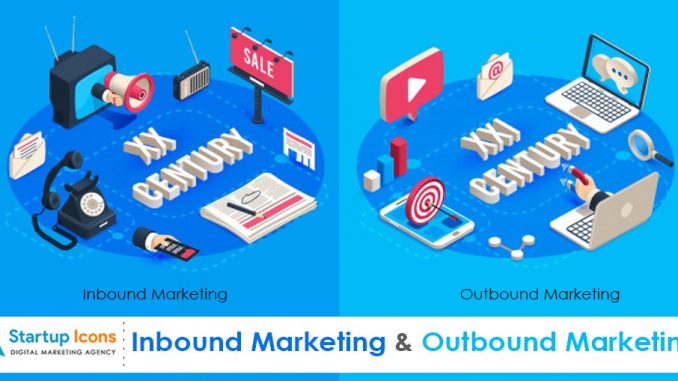
For many businesses, all the marketing activities to establish their brand in public fall under one umbrella. So, there wasn’t any necessity to differentiate the marketing strategies and tactics as “inbound” and “outbound” till the past few years. But, without acquiring proper knowledge about the roots of marketing strategies and implementing them just because of the trends rather than considering the business objectives made the marketing campaigns ineffective and did not drive better results as they should. And this led to the need to distinguish inbound and outbound marketing, ensuring success in the long term for each business.
While both inbound and outbound marketings are two distinct strategies and each type explains how the concept of marketing works differently across various channels, they can drive successful outcomes when implemented either individually or together. But before getting to know about the actual differences between inbound marketing and outbound marketing, let us first, understand the basic concept of each strategy.
What is Inbound Marketing?
In simple terms, inbound marketing is the concept of content marketing to attract potential customers, who are already interested in the service/products offered by the brands. Inbound marketing involves various forms of pull marketing by creating and sharing interesting content including blog posts, infographics, events, white papers, search engine optimization, email newsletters, social media, etc. Inbound marketing is effective in scaling up the business as it has the ability to convert prospects into customers, thus leading to increased conversions and
improving customer retention. With proper implementation of inbound marketing, businesses can gain trust, reputation, and generate revenue in their respective niche.
What is Outbound Marketing?
Contrary to inbound marketing, outbound marketing is defined as push marketing. It involves advertising to approach the desired audience directly on a wider scale. Some of the examples of outbound marketing include TV & Radio ads, billboards, banner and display advertising, newspaper and magazine ads, telemarketing, etc. Though outbound marketing has been around for generations, it continued to evolve with each advancement in technology. Hence in this digital world, outbound marketing continues to prove its ability to drive ROI for the businesses through new forms of outbound promotions such as paid advertising on social media and search engines.
| Inbound Marketing | Outbound Marketing |
| Customer-Centric Content:
Content is educational, relevant, and specific to the target audience |
Marketer-Centric Content:
Content is based on the product’s need and delivered to a broad class of audience |
| Permissive and Interactive:
Seeks permission from the customers and creates customized content to engage with the audience |
Interruptive and One-way communication:
Interrupts the customer and establishes a passive conversation |
| Targeted – Audience:
Focuses on the audience who are interested or looking for the product/service |
Generic Audience:
Pushes a specific message at everyone regardless of audience interest |
| Low cost & Long term:
Affordable and takes time to show effectiveness but drives results in the long run |
High cost & Short term:
Expensive and immediately visible results, but effective only for a short term |
| Customer-Driven Channels:
● Blogging ● Earned Social Media ● Search Engine Optimization ● Audience-specific Emails ● Pay per click Ads ● Events to establish public relations & customer retention ● Influencer Outreach |
Marketer-Driven Channels:
● Print Media including newspapers, magazine ads ● Broadcast on TV & Radio ● Banner & Display Advertising ● Social Media Advertising ● Press Releases ● Telemarketing ● Contextual Ads |
| Detailed Tracking:
Can figure out the effectiveness of campaigns with various tracking tools available and helps for future planning |
Lack of Data:
Hard to track the analytics and data to measure the effectiveness of the promotional activities |
Content is educational, relevant, and specific to the target audience
Content is based on the product’s need and delivered to a broad class of audience
Seeks permission from the customers and creates customized content to engage with the audience
Interrupts the customer and establishes a passive conversation
Focuses on the audience who are interested or looking for the product/service
Pushes a specific message at everyone regardless of audience interest
Affordable and takes time to show effectiveness but drives results in the long run
Expensive and immediately visible results, but effective only for a short term
● Search Engine Optimization
● Audience-specific Emails
● Pay per click Ads
● Events to establish public relations & customer retention
● Influencer Outreach
● Print Media including newspapers, magazine ads
● Broadcast on TV & Radio
● Banner & Display Advertising
● Social Media Advertising
● Press Releases
● Contextual Ads
Can figure out the effectiveness of campaigns with various tracking tools available and helps for future planning
Hard to track the analytics and data to measure the effectiveness of the promotional activities
Thus with a clear understanding of the difference between inbound and outbound marketing, marketing professionals can build their marketing plan with both types of marketing strategies in an integrated way to achieve their business objectives.
We Startupicons Digital Marketing Course in Secunderabad will teach you complete digital marketing course for more details https://www.startupicons.in/

Leave a Reply